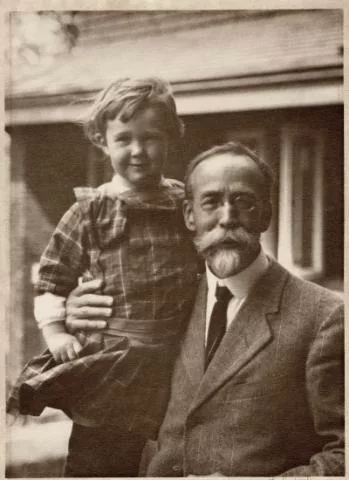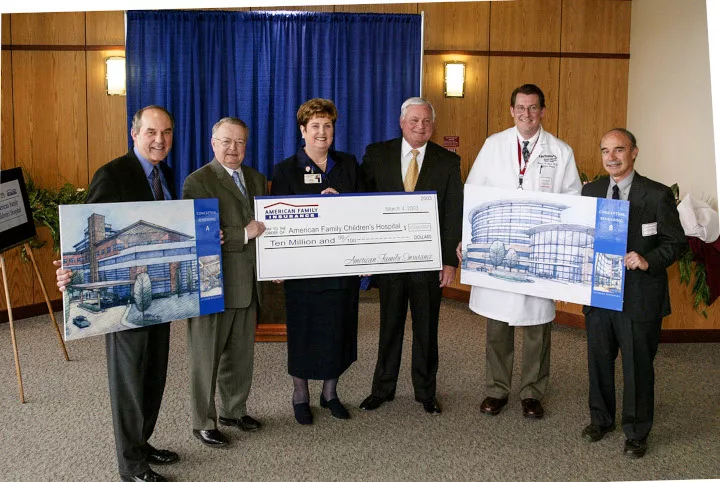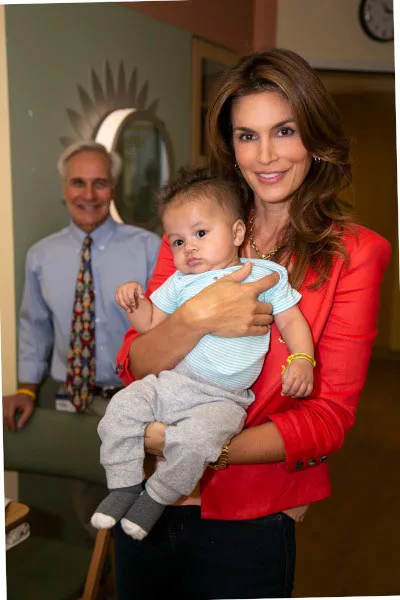Healer’s Journey: An Ode to My Ladies
Christine Seibert reflects on the concept of a social recession as her patients find themselves isolated by the COVID-19 pandemic.
When you hear “University of Wisconsin–Madison,” what comes to mind first?
Perhaps it’s the campus’ reputation as one of the nation’s greatest public universities, its status as an internationally known research institution, or its beautiful setting along Lake Mendota. Many identify with the Badgers’ countless achievements over the past generation in football, basketball, hockey and other sports.
Few people, however, may realize that 2020 commemorates the 100th year in which UW–Madison faculty and staff have been caring for hospitalized children. Four campus locations have served as a children’s hospital, although the first three pale in comparison to UW Health’s beautiful, nationally recognized American Family Children’s Hospital, which opened in 2007.
The story began in 1920, with the opening of the Mary Cornelia Bradley Hospital for the Study of Children’s Diseases. Professor Harold C. Bradley, PhD, and his wife, Josephine Bradley, provided most of the funding to construct a pediatric hospital on Linden Drive in memory of their daughter. At age 6, Mary Cornelia Bradley had been stricken with measles, and she died from complications in 1916.

“I am grateful that my grandparents did something so wonderful after something so devastating,” says Peggy Timmerman, the daughter of one of Mary Cornelia Bradley’s brothers. “Although Mary’s death was seldom talked about, I’m told that this generous gift to the university helped my grandmother cope with the tragic loss of her daughter.”
As befitted many hospitals of the early 20th century, the Bradley Hospital — and its successor, the Wisconsin Orthopedic Hospital for Children, which opened in 1930 nearby on Linden Drive — was not child-friendly by today’s standards. Noise was constant, visiting hours were few, and privacy was nonexistent. Typically, a single, large room housed eight or nine young patients, with nothing or just a drape separating them.
In that era, children with acute, severe illnesses, which often were infectious diseases, commonly died at home. The region’s acute-care pediatric wards were located at other community hospitals. Thus, patients admitted to the Wisconsin Orthopedic Hospital for Children generally were suffering from chronic diseases or having orthopedic surgery.
Yet, early on, surgical procedures were not conducted at this facility. For more than 30 years, pediatric patients who needed surgery “had to be taken outside via gurney transport, covered by bundled clothing and blankets during inclement weather” to University Hospital at 1300 University Avenue, according to an unpublished memoir by the late Gordon A. Tuffli, MD ’64, a longtime Madison pediatrician and faculty member of the UW School of Medicine and Public Health’s (SMPH) Department of Pediatrics.
The outdoor gurney rides ended by the late 1950s with the construction of a long, dimly lit tunnel that connected the Wisconsin Orthopedic Hospital (later renamed UW Children’s Hospital) to University Hospital, which opened in 1924. At the second children’s hospital, other improvements included the addition of a pediatric intensive care unit and development of programs for children with cancer, cystic fibrosis and other life-threatening disorders. The two original children’s hospital buildings and the old UW–Madison Archives 12 University Hospital building (now called the Medical Sciences Center) still house various UW–Madison programs.
Fast forward to 1979, when pediatric and adult patients were carefully transferred to the colossal Clinical Science Center (CSC), home of today’s University Hospital, on the far west end of campus. Philip Farrell, MD, PhD (PG ’72) — who joined the Department of Pediatrics faculty after completing his residency in that department, served as its chair from 1985 to 1995, and later served as the SMPH dean — recalls how excited the children were to “take a ride west” in their beds and move into individual rooms with their own bathrooms and televisions.
“Having a private room for each child was innovative 40 years ago,” says Paul Sondel, MD, PhD ’75 (PG ’80), the Reed and Carolee Walker Professor in Pediatric Oncology at the SMPH and the research director for the Department of Pediatrics’ Division of Pediatric Hematology, Oncology and Bone Marrow Transplant. “Yet, the rooms were cramped, and there was nothing childor family-friendly about the space.”
Over his 40-year career caring for pediatric cancer patients and conducting research at UW–Madison, Sondel has seen myriad improvements.
Among them is security. While not as paramount a concern in 1979 as it is today, security was lacking; in fact, health care providers and visitors routinely passed through pediatric units on their way to other areas of the CSC.
A dedicated pediatric hematology/ oncology unit opened in 1990, and in 1993, Child Life — a profession of therapists who help children cope with hospitalization — entered the picture. And building upon a program that started in the 1920s, staff of the UW Children’s Hospital School helped inpatients keep up with schoolwork; the offering continues today.

Farrell recalls that, at the CSC, pediatric general and specialty clinics expanded, and collaboration among Department of Pediatrics’ faculty members and those in other fields enhanced patient care. Further, programs such as organ transplantation gained national and international recognition.
Reflecting on other changes, Aaron L. Friedman, MD (PG ’78), cites the evolving profile of hospitalized children during his three decades on the Department of Pediatrics faculty.
“The child we hospitalize today is, on average, much sicker than the child we hospitalized 30 or more years ago. Back then, we hospitalized kids for procedures now done on an outpatient basis,” says Friedman, a pediatric nephrologist who completed his residency and fellowship in the Department of Pediatrics, joined its faculty in 1981 and served as chair from 1996 to 2005. “Today, we hospitalize mostly very sick children who, in the past, would have died. Now, most of them heal and go on to live normal lives.”
The lack of a true, identifiable children’s hospital proved a major drawback in several ways. The name “UW Children’s Hospital” — which existed before the 1979 move to the adult hospital — disappeared until 1988, when leaders resurrected the name for its pediatric facilities. Marketing materials of the era described a pediatric “hospital within a hospital,” touting the ample resources of a major academic medical center.
By the late 1990s, leaders became increasingly aware that the “hospital within a hospital” was inadequate, as inpatient care for children had become subsumed within a large hospital designed for adults.
Farrell and Friedman — both of whom cared for pediatric patients before and after the department’s 1979 move to the CSC — had insights into the unique needs of sick children and their families.
“Taking care of a sick child means caring for an entire family. You need space for parents, space for siblings. Moreover, children are not merely little adults; caring for them takes a different mindset and skill set,” says Friedman, who retired in 2013 from his role as vice president of health sciences and dean at the University of Minnesota Medical School, before moving back to Madison.
“With more children getting better and living longer, pediatric nursing, and physical and occupational therapy were growing as career choices,” he adds.
Like Friedman, Gordon Derzon acknowledged that the “hospital within a hospital” status quo was inadequate for sick children. In the years preceding his 2000 retirement as CEO of UW Hospital and Clinics, Derzon created a UW Children’s Hospital Advisory Board composed of a dozen business, community and hospital representatives, beginning a process that culminated in a state-of-the-art children’s hospital. The community became increasingly supportive.
“We started looking at options to improve the situation, which everyone agreed were urgently needed,” recalls John Flad, a member and future chair of the advisory board, lifelong Madison philanthropist and president of Flad Development and Investment Corporation. “We talked about everything from building a separate children’s entrance to constructing a free-standing children’s hospital elsewhere in Madison. The words ‘fun, exciting and whimsical’ were tossed around because we understood the importance of a more soothing, child-friendly environment.”
Two highly accomplished leaders arrived on the scene in 1999, infusing UW Health with new direction, energy and possibilities regarding pediatric hospitalization. First came Dennis Lund, MD, hired as the pediatric surgeon-in-chief who called upon his experience developing a Level 1 trauma program and large pediatric surgical practice at Boston Children’s Hospital. A few months later, from City of Hope cancer center in California, came Donna K. Sollenberger, who served as president and CEO of UW Hospital and Clinics from 1999 until 2007 and has since retired after a 44-year career in health care. They were determined to build a state-of-the-art children’s hospital in Madison — sooner rather than later.
“I remember taking Donna on a tour of our pediatric units during her first week as CEO,” says Lund, now chief medical officer for Lucile Packard Children’s Hospital at Stanford in Palo Alto, California. “She saw the small inpatient rooms, the lack of family amenities and the bone marrow transplant unit where kids would stay for weeks without a window. She got it right away, and that was unmistakably important.”
Friedman reflects, “Denny and Donna were instrumental — especially within the organization — in saying not only that patients and families deserve better, but our physicians, nurses and staff deserve better.”
What seemed to be a dream for many began crystallizing into reality. Flad Architects, a Madison-based planning and design firm founded by John Flad’s father and grandfather, agreed to provide feasibility and design services at no cost. This work suggested that any pediatric hospital should stay on campus to minimize duplication of culinary and other central services. Plans called for bright colors and an engaging “All-Things-Wisconsin” design, with spacious patient rooms, lounges and living amenities that make life as tolerable as possible for families that literally move in with their sick children.
Sensing that the community would financially support a modern children’s hospital, Sollenberger and the UW Hospital and Clinics Authority Board agreed to bond for approximately half of the $78 million cost, providing that the other half would be raised through philanthropy, a monumental task managed by the UW Foundation.
Step one in such a multi-year capital campaign is identifying a lead gift, which often includes naming rights.
“I told Donna I would like to ask American Family Insurance about a naming gift,” recalls Flad, whose development company had worked on several projects with the corporation. “And I didn’t think the marketing department would need to stay up late because we could call it ‘American Family Children’s Hospital.’ Here is a Fortune 500, Madison-based company, and I thought they might be interested.”
After weeks of discussions, American Family Insurance, led by then-Chair and CEO Harvey Pierce and then-President David Anderson, gave the thumbs-up. In exchange for having its name on the building, American Family Insurance made a $10 million gift with the understanding that its generosity would continue. As of 2020, the company’s total contributions approach $25 million.
Remembering his initial impression, Pierce says, “I visited the old pediatric ward and saw these sick kids struggling. We felt there was no finer gift than providing an environment where these children could heal more comfortably.”
The news about plans to build a children’s hospital adjacent to UW Hospital and about American Family Insurance’s generous gift was announced in early 2003. Construction of the six-story facility began the next year.
Addressing the need to raise the remaining $41 million, countless businesses, organizations and individuals from Madison and beyond responded overwhelmingly to the “No Finer Gift” capital campaign.
In 2004, Friends of UW Hospital and Clinics (now called Friends of UW Health) — a non-profit organization aimed at supporting patients and families — held a well-attended gala that yielded $250,000 for the building fund. Friends’ galas, which typically attract more than 1,000 guests, have been held biennially since. Cumulative proceeds to American Family Children’s Hospital from the galas and other Friends’ fundraisers total $7.95 million.
“The case for this children’s hospital made for an incredibly compelling story,” notes Nancy Francisco-Welke, vice president and managing director, UW Foundation. “All across the community and beyond, so many people reached into their hearts, allowing our most vulnerable children to get the very best care close to home.”

Following the hospital’s 2007 opening, demand for rooms and clinical care grew sharply, resulting in plans for a major expansion just five years later. Again, UW Foundation launched a successful campaign, “Sick Kids Can’t Wait,” to raise $16 million. By 2014, the hospital included two additional stories and was able to offer enhanced care for acutely ill babies and children.
Key additions included a 24-bed surgical neonatal intensive care unit and a pediatric imaging suite, including a first-in-the-world “hybrid” catheterization/angiography lab with very low-dose radiation.
While it is beautiful, spacious and technologically advanced, American Family Children’s Hospital represents much more than a state-of-the-art building. Located at 1675 Highland Avenue, the 111-bed hospital’s nurses, physical and occupational therapists, physicians and other health care professionals — many with national reputations — make it a world-class place.
There have been many extraordinary accomplishments at American Family Children’s Hospital, including:
Four phases of children’s hospital development at UW–Madison have brought together people and programs dedicated to improving the care of children and their families. During each era, advances led to the need for better facilities, and this has culminated in the magnificent American Family Children’s Hospital.
“It is really a remarkable story,” says Ellen Wald, MD, who was named chair of the Department of Pediatrics and physician-in-chief of UW Children’s Hospital (now American Family Children’s Hospital) in 2006. “And our strong place on the national and global maps validates the decision to build this hospital. We’ve been on an amazing journey of pediatric care, and we’re looking forward to another 100 years of outstanding care and clinical discoveries.”